Breath of Fire Original Soundtrack Special Box: Breath of Fire V
 |
Album Title: Breath of Fire Original Soundtrack Special Box Discs 10 & 11 |
| Record Label: Suleputer |
|
| Catalog No.: CPCA-10155/6 |
|
| Release Date: March 31, 2006 |
|
| Purchase: Buy Used Album |
Overview
The most recent instalment to one of Capcom’s most successful RPG series, Breath of Fire V: Dragon Quarter, saw Hitoshi Sakimoto challenge himself once more by creating one of his most diverse scores to date. While many associate him with the dark symphonic textures of Vagrant Story or the epic militaristic flair of Final Fantasy Tactics, he has incredible versatility in terms of both the emotions he expresses and in the styles he adopts. This score, more than any other of his works, features the most variety of his styles to be featured on one score, including lighter tunes akin to Final Fantasy Tactics Advance, exotica reminiscent of Legaia Duel Saga, and electro-acousticism associated with Soukyuugurentai. The score was programmed by a team of three from Procyon Studio under the direction of Yasunori Mitsuda, while Sakimoto largely worked independently. It was initially released as a complete two disc soundtrack and was late repackaged into the series’ complete box.
Body
Sakimoto creates a few dark ambient creations throughout the album. He typically utilises mysterious synth vocals, and though this is a slightly hackneyed technique, it is very effective. “Waste Shaft,” for example, develops over a five minute period, encompassing a variety of contrasting sections that fit effortlessly thanks to seamless transitions; filled with character thanks to high-pitched vocal chants and industrial sound effects, synthesized impeccably by Yasunori Mitsuda’s team, this track has the power to send a shiver down any listener’s spine. Equally profound choral use is reflected in “Origin” and the organ-led “A Distant Call”,” where elegant contrapuntal harmonies interweave with the vocals beautifully. Not all the dark tracks adopt such styles: “A Small Journey” utilises beautifully realised acoustic and electric piano samples to create an ethereal feeling; “Sorrowful Memories” resounds with richness and sadness thanks to the string suspensions and interweaving melodic lines; and “Power Supply Building” features light techno layering and a variety of sound effects yet evokes great beauty with its profound melodies, filled with hope and sadness. All are remarkably crafted examples of Sakimoto’s ability to interpret a complex array of feelings through delicate and original means.
Having made his name in action RPGs such as Ogre Battle and Final Fantasy Tactics, it’s no surprise that Sakimoto’s action tracks on the soundtrack are mostly excellent. “Attack,” for example, evokes a feeling of coercion by carefully synchronising imposing brass fanfares and a rhythmically static but unnervingly persistent ‘cello bass line. “Going Out to See the Sky” also relies of a driving pulse through using punchy and crisp phrasing as the basis for all sorts of clever ‘call and response’ interplay and ascending chromatic sequences. Other tracks, notably “Kokon-Horay”, “Imminent Crisis”, and the roaring “Sealed,” layer various forces upon rhythmically strong foundations, perhaps inspired by the late Jerry Goldsmith’s The Planet of the Apes. Through combining repeating strings, dissonant piano chords, unusual percussive effects, and, at least in the lattermost, various electronic noises, the timbre changes every few moments, gripping the listener because of unpredictability and a sense of motion. In addition, there are typical but effective militaristic themes akin to Final Fantasy Tactics such as “Harbinger” and those more associable with infiltration, for example “Ranger HQ”.
Some of Sakimoto’s lighter contributions to the soundtrack are delightfully whimsical. “Low Sector Borough” feels like it should belong in Final Fantasy Tactics Advance. Led by a brilliant brass melody, the charm of the theme comes from the way pizzicato strings and other instruments buoyantly harmonise and echo the theme. “Let’s Go With a Smile” features a fantastical array of lyrically phrased melodic fragments that are elegantly passed between various instruments and interwoven with each other from the basis of some bouncy rhythms. It’s also notable that Sakimoto adds colour to some action themes through use of novelty sounds. For example, “Industrial Sector” uses highly amusing percussion use throughout while “Lifeline” relies on microtonality in places with one part being treated with various glissandi and reverbs. Both are superbly inventive and very convincing scene-setters for an industrial environment, however, among the most interesting and effective additions to the soundtrack. Strangest of all, however, is “Biocorp”. Featuring sounds akin to a frog croaking, whatever inspired Sakimoto to create this? Sakimoto’s quirky musical humour and playfulness is a treasure to come across, particularly in the middle of an otherwise serious and action-packed soundtrack.
The conclusion to the album is one of the most heartfelt of any Sakimoto’s albums. “Ending” attains an incredible level of fluidity and allows the listener to glide in an elevated state while the main theme subtly recapitulates. Though a programmatic piece intended to accompany a complex and ever-developing scene, no part of the composition feels forced musically — even the build up to the dramatic and majestic conclusion approaches tension effortlessly before resolving it blissfully. The subsequent “Castle – Imitation (Breath of Fire V Dragon Quarter),” composed and sung by Chihiro Onitsuka, jarringly differs to the rest of the soundtrack. It replaces the ‘Sakimoto sound’ for a somewhat aseptic sounding vocal ballad that utilises a standard combo of piano, electric bass, and electric guitar to create a plain and predictable harmonic line. Onitsuka’s vocal performance is the sole highlight and her regular repetition of a word in certain parts of the piece emphasises the meaning of the Japanese lyrics while assisting the process of making an otherwise lumpy composition glide. After a strange assortment of miscellaneous bonus pieces (including the misplaced “Prologue”), the album ends with “Escaping the Present”, an emotional rollercoaster. It reflects on the gamer’s experiences and the soundtrack’s varying moods in a musically fluid yet emotionally wrought way and is ever more disturbing and beautiful on close analysis.
Summary
The most diverse Hitoshi Sakimoto soundtrack to date, the Breath of Fire V: Dragon Quarter soundtrack is highly recommended for most fans of his other well-known works and a strong introduction to the composer to newcomers. While retaining an overall emphasis on action-packed orchestral themes, the soundtrack features ambient scene-setters, haunting chorales, delightful ditties, symphonic epics, and novel anomalies, with light electronica tinges and a vocal theme to boot. The vocal theme and a few filler tracks excluded, the soundtrack is consistently intricate, charming, and appropriate, delighting from start to finish.
Do you agree with the review and score? Let us know in the comments below!
4
Posted on August 29, 2010 by Chris Greening. Last modified on May 27, 2014.














